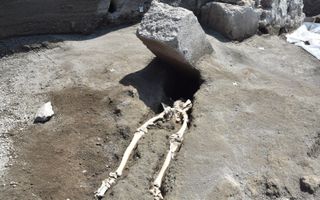Pompeii Man Had a Really, Really Bad Day 2,000 Years Ago

Archaeologists in Pompeii just unearthed the headless skeleton of an unfortunate man who appears to have died in the great explosion of Mount Vesuvius in A.D. 79. The man was decapitated by a large, 1-meter-long rock, researchers found.
The man, who was at least 30 years old, was the first victim to be found in a new, unexplored excavation site called Regio V, north of the city, according to a statement from the Pompeii Archaeological Park.
"We are digging all around," trying to find the head, said Massimo Osanna, the archaeological park's general director. The rock appears to have crushed the man's chest and head. Though the man died while trying to flee the aftermath of the eruption, he probably wasn't killed by the rock, but rather by the dense layer of hot ash, lava and gas, or "pyroclastic flow," that poured into the area, Osanna said.
Archeologists found his body on the first floor of a building, above a layer of "lapilli," or small rock fragments from the volcano. The skeleton was in a position that indicated that the man had been thrown back by force, probably from the pyroclastic flow, Osanna said. Since the man's tibia bone had lesions in it, the scientists suspect he may have had a bone infection that prevented him from quickly escaping, the statement said. [25 Grisly Archaeological Discoveries]
Last February, at another excavation site, scientists also discovered the skeleton of a 7- or 8-year-old child who they think was seeking safety in a public bath, but was suffocated by clouds of ash, according to The Telegraph.
The man and child were just two of thousands of people thought to have perished in the catastrophic Mount Vesuvius explosion that took place nearly 2,000 years ago, burying Pompeii beneath 19 to 23 feet (6 to 7 meters) of volcanic ash. These layers of ash preserved skeletons and have been giving scientists a glimpse of life and death in the ancient Roman city since excavations began in the 18th century.
But with new excavation techniques, such as drones, laser scanning and photogrammetry (making measurements from photographs), new skeletal discoveries can provide a more detailed story of ancient Pompeii and its demise, Osanna said. With all the different technologies, "now we can document everything," he said.
Sign up for the Live Science daily newsletter now
Get the world’s most fascinating discoveries delivered straight to your inbox.
As the only active volcano on mainland Europe, scientists still worry about Mount Vesuvius' potential to inflict serious damage on nearby Naples and other towns, Live Science previously reported. After all, it did destroy Pompeii in just 25 hours.
Originally published on Live Science.

Yasemin is a staff writer at Live Science, covering health, neuroscience and biology. Her work has appeared in Scientific American, Science and the San Jose Mercury News. She has a bachelor's degree in biomedical engineering from the University of Connecticut and a graduate certificate in science communication from the University of California, Santa Cruz.
